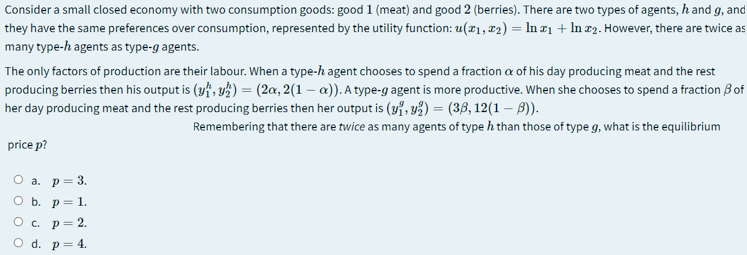Consider a small closed economy with two consumption goods: good 1 (meat) and good 2 (berries). There are two types of agents, h and g, and they have the same preferences over consumption, represented by the utility function: u(¤1,72) = In z1 + In z2. However, there are twice as many type-h agents as type-g agents. The only factors of production are their labour. When a type-h agent chooses to spend a fraction a of his day producing meat and the rest producing berries then his output is (yf', y;) = (2a, 2(1 – a)). A type-g agent is more productive. When she chooses to spend a fraction B of her day producing meat and the rest producing berries then her output is (vĩ, v5) = (38, 12(1 – B)). Remembering that there are twice as many agents of type h than those of type g, what is the equilibrium price p? a. p= 3. O b. p= 1. O c. p= 2. O d. p= 4. O O O O
Consider a small closed economy with two consumption goods: good 1 (meat) and good 2 (berries). There are two types of agents, h and g, and they have the same preferences over consumption, represented by the utility function: u(¤1,72) = In z1 + In z2. However, there are twice as many type-h agents as type-g agents. The only factors of production are their labour. When a type-h agent chooses to spend a fraction a of his day producing meat and the rest producing berries then his output is (yf', y;) = (2a, 2(1 – a)). A type-g agent is more productive. When she chooses to spend a fraction B of her day producing meat and the rest producing berries then her output is (vĩ, v5) = (38, 12(1 – B)). Remembering that there are twice as many agents of type h than those of type g, what is the equilibrium price p? a. p= 3. O b. p= 1. O c. p= 2. O d. p= 4. O O O O
Chapter13: General Equilibrium And Welfare
Section: Chapter Questions
Problem 13.4P
Related questions
Question

Transcribed Image Text:Consider a small closed economy with two consumption goods: good 1 (meat) and good 2 (berries). There are two types of agents, h and g, and
they have the same preferences over consumption, represented by the utility function: u(x1,x2) = In ¤1 + In r2. However, there are twice as
many type-h agents as type-g agents.
The only factors of production are their labour. When a type-h agent chooses to spend a fraction a of his day producing meat and the rest
producing berries then his output is (yf, y) = (2a, 2(1 – a)). A type-g agent is more productive. When she chooses to spend a fraction B of
her day producing meat and the rest producing berries then her output is (yi, v3) = (36, 12(1 – B)).
Remembering that there are twice as many agents of type h than those of type g, what is the equilibrium
price p?
О а. р— 3.
ОБ. р3 1.
O c. p= 2.
O d. p= 4.
Expert Solution
This question has been solved!
Explore an expertly crafted, step-by-step solution for a thorough understanding of key concepts.
Step by step
Solved in 2 steps

Knowledge Booster
Learn more about
Need a deep-dive on the concept behind this application? Look no further. Learn more about this topic, economics and related others by exploring similar questions and additional content below.Recommended textbooks for you

